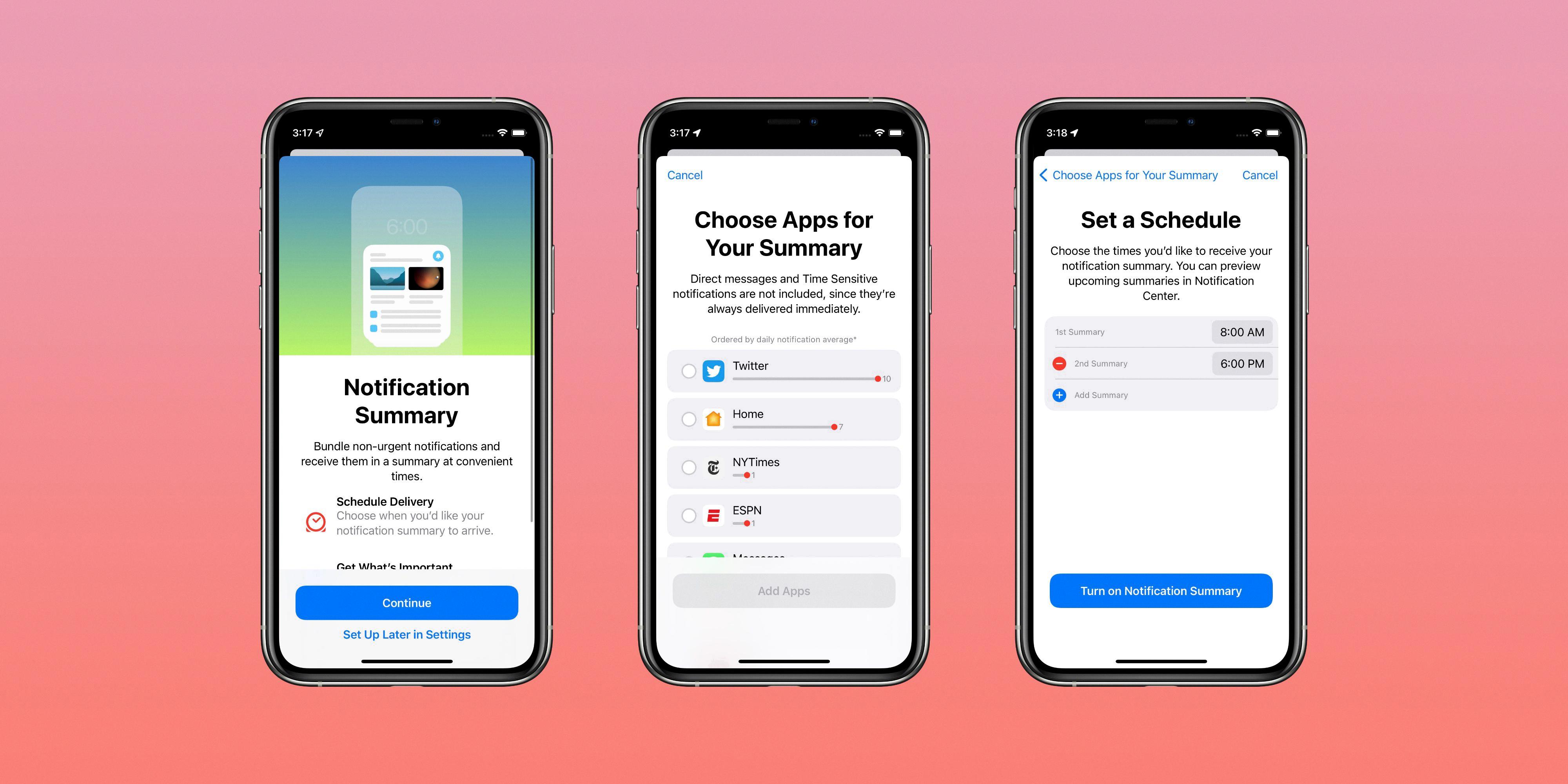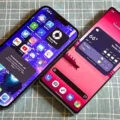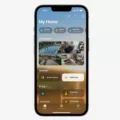In the ever-evolving world of technology, our devices are constantly bombarding us with notifications. Whether it’s a text message, a social media update, or a news alert, these notifications can sometimes be overwhelming and disrupt our focus. However, with the introduction of iOS 15 and iPadOS 15, Apple has come up with a solution to help us manage this digital chaos – the scheduled summary.
So, what exactly is a scheduled summary? Well, it’s a feature that allows you to set specific times to receive a summary of your notifications. Instead of being constantly interrupted throughout the day, you can choose to have all your notifications delivered to you at a designated time, when it’s convenient for you to catch up. This way, you can stay in control of your digital life and avoid the constant distraction of notifications.
The scheduled summary is personalized to you and ordered by priority based on how you use your apps. This means that the most relevant notifications will be at the top of your summary, ensuring that you don’t miss anything important. It’s like having a personal assistant curate your notifications for you, so you can focus on what matters most.
To make use of this feature, you’ll need to check the notification settings for your apps. Ensure that notifications are turned on and set to the correct sound or vibration that you prefer. This way, you won’t miss any important alerts when they are delivered to you in the scheduled summary.
If you’re an Android user and wondering how to manage your notifications in a similar way, there are a few things you can try. First, restart your Android device. Sometimes, temporary software glitches can interfere with notifications, and a simple restart can fix the issue.
Next, go to your device’s settings and navigate to the notifications section. Here, you can select the specific app for which you’re not receiving alerts and make sure that notifications are turned on. If they are already turned on, but you’re still not receiving alerts, check the “Alert Style When Unlocked” setting. It might be set to “None,” which means you won’t receive any banners or alerts for that app. Change it to “Banners” or “Alerts” to ensure you receive notifications.
Lastly, if you’re texting someone and notice that their notifications are silenced, it could be because they have enabled a Focus Mode on their iPhone or iPad. Focus Mode allows users to customize their notification settings based on their current activity or needs. It could be that the person you’re texting has enabled Sleep Mode, Do Not Disturb, or another Focus Mode. In this case, their notifications will be temporarily silenced until they disable the Focus Mode.
The scheduled summary feature introduced in iOS 15 and iPadOS 15 is a game-changer when it comes to managing notifications. It allows users to have more control over when and how they receive alerts, minimizing distractions and improving productivity. Android users can also explore various settings to manage their notifications effectively. So, take advantage of these features and regain control over your digital life.
What Does Scheduled Summary Mean On iPhone?
The scheduled summary feature on iPhone refers to the ability to set specific times to receive a consolidated summary of your notifications. This summary is designed to help you catch up on your notifications when it’s convenient for you.
With iOS 15 and iPadOS 15 or later, the summary is personalized to your usage patterns and is organized based on priority. This means that the most relevant notifications will appear at the top of the summary.
To further explain, here are some key points about the scheduled summary feature:
1. Personalization: The summary is tailored to your individual preferences and usage patterns. It takes into account how you interact with different apps to prioritize the notifications that matter most to you.
2. Consolidation: Instead of receiving notifications throughout the day, the scheduled summary gathers them all together in a single notification. This helps reduce interruptions and allows you to focus on other tasks without constant distractions.
3. Priority ordering: The notifications within the summary are ordered based on their importance and relevance to you. The system learns which notifications you tend to interact with and prioritizes those at the top of the list.
4. Convenience: By scheduling the summary at specific times, you can choose when you want to review your notifications. This can be particularly useful during busy periods or when you want to set aside dedicated time to catch up on your messages, emails, and other notifications.
The scheduled summary feature on iPhone allows you to receive a consolidated and personalized overview of your notifications at designated times. This helps you stay focused, reduce interruptions, and conveniently catch up on important information when it suits you best.

Why Are You Not Getting Notifications Even Though They Are Turned On?
There could be several reasons why you are not receiving notifications on your Android device, even though they are turned on. Here are some potential causes and solutions to help troubleshoot the issue:
1. Notification settings: Start by checking the notification settings for your app. Go to the app’s settings and ensure that notifications are enabled. You may also want to check if you have customized the notification preferences within the app itself, as some apps offer additional settings for notifications.
2. Sound or vibration settings: Verify that the sound or vibration settings for notifications are correctly configured. Sometimes, notifications may be turned on, but the sound or vibration settings may be disabled or set to a different option. Go to your device’s settings, find the sound or vibration settings, and make sure they are set to your desired preference.
3. Do Not Disturb mode: Check if your device is in Do Not Disturb mode. This mode can silence all notifications, so it’s worth confirming if it’s enabled. Swipe down from the top of your screen to access the quick settings panel and check if the Do Not Disturb icon is active. If it is, you can disable it to allow notifications.
4. App battery optimization: Some Android devices have battery optimization features that can restrict background activities for apps, including notifications. Check if the app you are experiencing issues with is being optimized for battery usage. You can find this setting in your device’s settings under “Battery” or “Battery optimization.” If the app is optimized, you can try disabling optimization for that particular app.
5. App permissions: Ensure that the app has the necessary permissions to send notifications. Go to your device’s settings, find the app settings, and make sure the app has permission to access notifications. If it doesn’t, enable the permission to allow notifications.
6. Restart your device: A simple restart can often resolve temporary software glitches that may be interfering with notifications. Restart your Android device and check if notifications start working again.
If none of these steps resolve the issue, it’s possible that there may be a deeper problem with either the app or your device’s software. In such cases, you may want to consider updating the app, checking for software updates on your device, or contacting the app’s support team for further assistance.
Why Are You Not Receiving Notifications On Your iPhone?
There could be several reasons why you are not receiving notifications on your iPhone. Here are some possible explanations and troubleshooting steps to resolve the issue:
1. Check if notifications are enabled for the specific app: Open the Settings app and go to Notifications. Make sure that the app in question has notifications turned on. If not, toggle the switch to enable them.
2. Ensure that Do Not Disturb mode is turned off: If your iPhone is in Do Not Disturb mode, notifications will be silenced. You can check this by swiping down from the top right corner of the screen to access the Control Center. If the crescent moon icon is highlighted, tap it to turn off Do Not Disturb mode.
3. Verify that the app’s notification settings are properly configured: Within the Notifications settings, select the app and review its specific notification settings. Ensure that you have selected the desired alert style (Banners, Alerts, or other options).
4. Confirm that your iPhone is not in Silent mode: Check the physical switch on the side of your iPhone. If it is flipped towards the back of the device, it means the Silent mode is activated. Push the switch towards the front to turn off Silent mode.
5. Restart your iPhone: Sometimes, a simple restart can fix minor software glitches. Press and hold the power button until the “slide to power off” slider appears. Slide it to turn off your iPhone, then press and hold the power button again to turn it back on.
6. Update your iPhone’s software: Outdated software can sometimes cause issues with notifications. Go to Settings > General > Software Update to check if there are any available updates. If an update is available, follow the prompts to install it.
7. Reset all settings: If none of the above steps work, you can try resetting all settings on your iPhone. Go to Settings > General > Reset > Reset All Settings. Note that this will not erase your data, but it will reset all personalized settings to their default values.
If you have tried all these steps and you are still not receiving notifications, it may be worth contacting Apple Support or visiting an Apple Store for further assistance.
Why Are Your Notifications Silenced?
The reason you see “notifications silenced” is because the person you are texting has activated a Focus Mode on their device. A Focus Mode is a feature available on iPhones and iPads that allows users to customize their notification settings to minimize distractions. When someone activates a Focus Mode, it can have various effects on their device’s notifications.
One possibility is that the person has enabled the Do Not Disturb mode. This mode prevents any incoming calls, messages, or notifications from making sounds or appearing on the screen. It is often used when someone wants to focus on a specific task or during specific hours, such as during meetings, sleep, or work.
Another possibility is that the person has activated Sleep mode. This mode is designed to promote healthy sleep habits by reducing interruptions during bedtime. When Sleep mode is enabled, notifications are silenced, and only important calls or contacts can bypass the mode.
Additionally, there are different types of Focus Modes that can be customized based on individual preferences. These modes allow users to prioritize certain apps or contacts while limiting or muting notifications from others. By enabling these modes, people can create personalized environments that suit their needs, such as work mode, personal mode, or exercise mode.
When you see “notifications silenced,” it indicates that the person you are texting has taken measures to control and limit distractions on their device. This can include activating Do Not Disturb, Sleep mode, or utilizing one of the various Focus Modes available on their iPhone or iPad.
Conclusion
The scheduled summary feature in iOS 15 and iPadOS 15 is a convenient tool that allows users to receive a personalized summary of notifications at a designated time each day. This feature helps users stay organized and catch up on important notifications when it’s convenient for them. The summary is ordered by priority based on the user’s app usage, ensuring that the most relevant notifications are displayed at the top. By scheduling a specific time for the summary, users can avoid being constantly interrupted by notifications throughout the day and instead have dedicated time to review and respond to them. This feature can be particularly useful for individuals who are busy or easily distracted, as it helps streamline the notification experience and allows for better focus and productivity. the scheduled summary feature is a valuable addition to the notification settings, providing users with greater control over their device’s alerts and enhancing their overall user experience.







